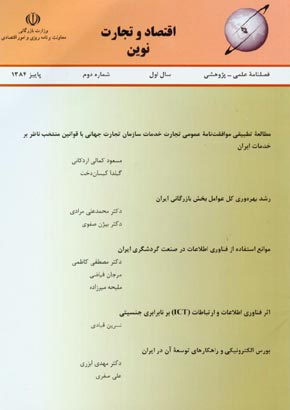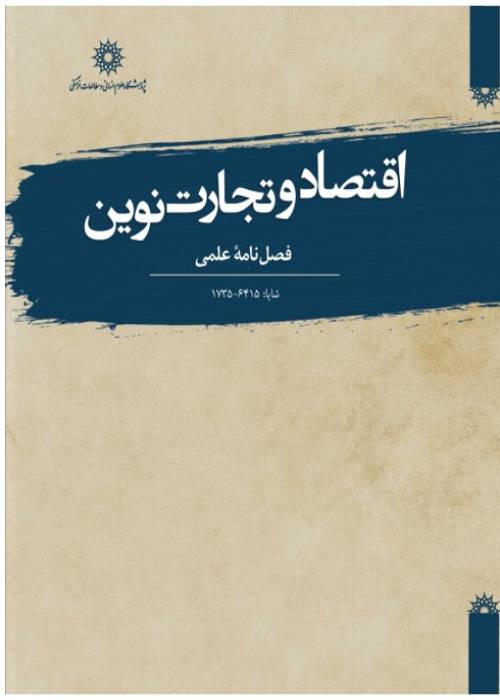فهرست مطالب

نشریه اقتصاد و تجارت نوین
پیاپی 2 (پاییز 1384)
- 128 صفحه، بهای روی جلد: 10,000ريال
- تاریخ انتشار: 1384/10/10
- تعداد عناوین: 7
- مقالات
-
صفحه 1فرایند طولانی الحاق به سازمان تجارت جهانی با پذیرش ناظر ایران آغاز گردید، یکی از الزامات الحاق به این سازمان، تطبیق مقررات داخلی کشور متقاضی الحاق، با قوانین و مقررات مندرج در موافقت نامه های سازمان مذکور می باشد. موافقت نامه عمومی تجارت خدمات، یکی از توافقات اساسی سازمان تجارت جهانی به شمار می رود. هدف مقاله بررسی این سوال است که طی فرایند الحاق کشور به این سازمان و پذیرش موافقت نامه خدمات، قوانین کشور تا چه میزان قابلیت انطباق با مفاد این موافقت نامه را دارد؟ ...
کلیدواژگان: تجارت بین الملل، تجارت الکترونیک، سازمان تجارت جهانی، موافقت نامه تجارت خدمات، قوانین ایران -
صفحه 30این مقاله مولفه های مهم و موثر رشد بهره وری کل عوامل بخش بازرگانی کشور را شناسایی و با استفاده از داده های سالانه دوره 1382 - 1338، اثر آنها را در قالب مدل شناسایی شده برآورد می کند. ابتدا برای محاسبه بهره وری کل عوامل، تابع تولید بخش بازرگانی، تخمین و سپس بر اساس سهمی عوامل تولید در رشد بخش داشته اند، شاخص بهره وری کل عوامل محاسبه و در نهایت در قالب مبانی نظری موضوع، عوامل کلیدی تعیین کننده رشد بهره وری کل عوامل بخش شناسایی و مدل ذی ربط برآورد شده است...
کلیدواژگان: بهره وری کل عوامل، سرمایه انسانی، نرخ تورم، نرخ ارز واقعی، بخش بازرگانی، ایران -
صفحه 49هدف این مقاله، بررسی و مطالعه موانع استفاده از فناوری اطلاعات در صنعت گردشگری ایران است. در این مقاله موانع استفاده از فناوری اطلاعات در قالب 6 طبقه مدیریتی، انسانی، فرهنگی - اجتماعی، سازمانی - ساختاری، فنی - تکنولوژیکی و محیطی طبقه بندی و با روش میدانی مورد بررسی و تحلیل قرار گرفته اند. شش طبقه عوامل یاد شده به 26 عامل فرعی تر تقسیم و رتبه بندی گردیده اند. نتایج نشان می دهد به جز عوامل طبقه سازمانی - ساختاری و مدیریتی، سایر عوامل به عنوان مانع استقرار فناوری اطلاعات در صنعت گردشگری ایران مطرح می باشند...
کلیدواژگان: گردشگری، فناوری اطلاعات، گردشگری الکترونیک، آزمون فرضیه، روش میدانی، ایران -
صفحه 67ارتقاء برابری جنسیتی یکی از هداف مهم یک اقتصاد کارآمد و از راهبردهای توسعه انسانی است. مقایسه داده های کشورها نشان می دهد که رابطه مثبت و معنی داری بین برابری جنسیتی و توسعه اقتصادی وجود دارد. علی رغم تلاش های بسیاری که هم، در سطح ملی و هم، در سطح بین المللی در رفع نابرابری و کاهش شکاف جنسیتی انجام شده است، هنوز نابرابری در ابعاد مختلف آن در سطح جهان و حتی در کشورهای توسعه یافته وجود دارد. در کشورهای در حال توسعه نابرابری شدیدتر است و. این امر فقر این کشورها را تشدید می کند...
کلیدواژگان: شکاف جنسیتی، ICT، نابرابری جنسیتی در تحصیل، نابرابری جنسیتی در کار و آموزش -
صفحه 86از آنجایی که رشد و پویایی اقتصاد کشور بدون مشارکت تمامی اقشار جامعه امکان پذیر نمی باشد، فراهم سازی امکان سرمایه گذاری عمومی از طریق بورس اوراق بهادار می تواند گامی در جهت افزایش مشارکت جمعی در توسعه اقتصاد ملی محسوب گردد. هدف این مقاله بررسی زیر ساختها و ارایه راهکارهای مناسب جهت ایجاد و گسترش داد و ستدهای الکترونیکی سهام در بازار سرمایه کشور می باشد. در این راستا، روش تحقیق بکار گرفته شده از نوع توصیفی - تحلیلی است و ابزار جمع آوری اطلاعات و آمار آن به روش کتابخانه ای می باشد...
کلیدواژگان: بورس الکترونیکی، بورس اوراق بهادار، راهکارها، ایران -
راهنمای نویسندگانصفحه 107
-
چکیده انگلیسیصفحه 111
-
Page 1The long process of Iran's accession to the World Trade Organization (WTO) has started as Iran obtained the observer status recently in the WTO. One of the main WTO requirements is to review and examine the compatibility of current applicant regulations with the General Agreement on Trade in Services (GATS). The GATS is one of the obligatory agreements of the WTO and accordingly the Iranian legislation is required to ratify GATS as well. This article first reviews the provisions of the GATS as the Preliminary legal instrument of services in international trade and then examines its compatibility with the current Iranian laws and regulations. The article concludes that with respect to the GATS flexibility in nature, the Iranian legal system is capable to meet the requirements of the WTO in respect to GATS.Keywords: WTO, GATS, International Trade, Electronic Commerce, Iran
-
Page 30This paper explores what are the main determinants of total factor productivity (TFP) growth of the commerce sector in Iran. The analysis is performed using annual data over the period 1959 - 2003. This paper takes a fresh empirical look at the main determinants of TFP growth in the commerce sector where the TFP growth is negative on average and is associated with substantial variance over the period of the study. We try to disentangle the impact of human capital, physical capital, real exchange rate, and inflation on TFP growth. The production model is first specified in terms of the level of variables and then the TFP growth model is specified in terms of rates of change in the variables except real exchange rate which is stationary. The Coefficients of the explanatory variables turn out to be highly significant in the regression. The results presented in this paper are clear. Human capital, physical capital, and real exchange rate have positive effects while the rate of inflation has a negative effect on the TFP growth of the commerce sector in Iran. The TFP model shows that there are two outliers and one dummy variable in the model and their coefficients are statistically different from zero.Keywords: TFP Growth, Commerce Sector, Human Capital, Iran
-
Page 49The aim of this article is to analyze the barriers for implementing Information Technology (IT) in the Iranian tourism industry. Electronic tourism uses IT in traveling and tourism. This study is an applied one, using descriptive and survey methods. The findings of the study show that among 26 factors, classified in six main factors: managerial, human resource, cultural-social, organizational-structural, technological and environmental factors. The results confirm that four main factors have significant function for implementing IT in the Iranian tourism industry. These factors include human resource, cultural-social, technological and environmental factors.Keywords: Information Technology, Electronic Tourism, Survey Method, Hypothesis Testing, Iran
-
Page 67Promoting gender equality is an essential component of effective economic and human development strategic goals. Despite all efforts to eliminate gender gap in national and international levels, various forms of inequality still exist around the world even in the developed countries. Inequality is stronger in the developing countries in the comparison with the developed countries and this is one of the elements enhancing their poverty. This paper investigates the effects of information and communication technologies (ICTs) on gender inequality. Panel data estimates are employed based on the country random effects using the World Bank data over the period 2000-2002. The findings of the paper show that increases in the level of ICT infrastructure tend to be improved gender equality using the education and employment measures.Keywords: Gender Gap, Panel Data, ICT, Gender Inequality in Education, Employment
-
Page 86The last decade has witnessed a dramatic increase in the number and the market share of electronic trading in the stock market over the world, since electronic trading has improved the efficiency of stock markets and hence has reduced the cost of providing liquidity. It does offer lower operating costs and the possibility of remote access to the market. This paper addresses the issue of electronic stock trading system in Iran. More specifically, we extend our understanding of the role of electronic stock market and discuss the implications of the results for the designing of electronic trading systems in the country. The results of this paper show that the electronic stock trading faces with the lack of sufficient infrastructures such as information and communication technology (ICT), electronic banking, electronic commerce, and regulations. Therefore, it is required improving hardware, software, and physical infrastructures in the country. The results of this paper can be used by financial and economic policymakers, capital market decision makers to implement ICT in the stock exchange markets.Keywords: Electronic Stock Trading, ICT, Stock Exchange Market, Iran


